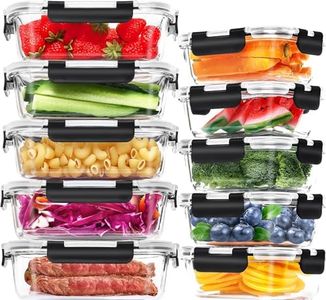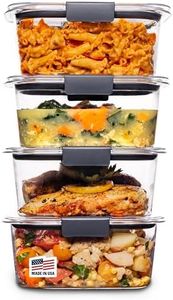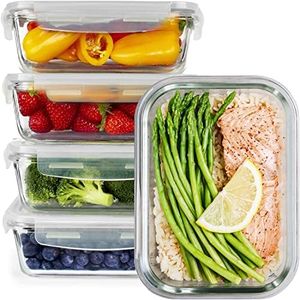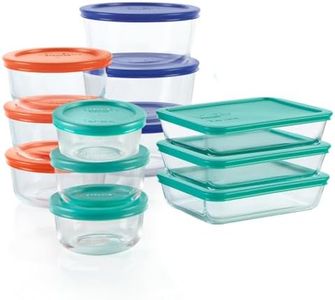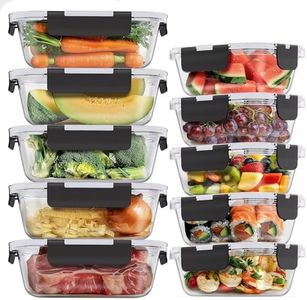We Use CookiesWe use cookies to enhance the security, performance,
functionality and for analytical and promotional activities. By continuing to browse this site you
are agreeing to our privacy policy
10 Best Meal Prep Containers
From leading brands and best sellers available on the web.By clicking on a link to a third party's website, log data is shared with that third party.
Buying Guide for the Best Meal Prep Containers
Choosing the right meal prep containers can make food storage safer, more efficient, and easier to organize. When you’re selecting containers, consider how you use your fridge and freezer, what kinds of meals you prepare, and how often you’ll be eating on the go. The right container should keep your food fresh, be easy to clean, and suit your lifestyle.MaterialMeal prep containers are typically made from plastic, glass, or sometimes stainless steel. Material affects durability, weight, and how you can use the container, like whether you can microwave or freeze it. Plastic containers are lightweight and less likely to break, but they can stain and may not last as long. Glass is heavier but is better for reheating and doesn't retain odors or stains. Stainless steel is very durable and lightweight but usually can’t go in the microwave. Think about whether you need to carry your meals, microwave them, or store food for longer periods when making your choice.
Size and CapacityContainer capacity can range from small snack-sized to large meal-sized options. This is important because using the right size helps avoid food waste and ensures portability. Small sizes are good for snacks or sauces, medium for single meals, and large sizes great for salads or full entrees. Consider what types of meals you usually prepare and how much you typically eat; match the container size to your portion preferences.
CompartmentsSome containers have multiple sections to separate different types of food, while others are just one open space. Compartments are helpful if you want to keep foods from mixing (like sauce and salad, or entree and sides). Single compartment containers are more versatile but may not keep foods as fresh, especially if moisture is a concern. Think about your typical meals—if you like variety and separation, opt for multiple compartments; if you pack simple meals, single compartments may be enough.
Seal and Leak-Proof FeatureA good seal is essential for keeping food fresh and avoiding spills in your bag or fridge. Some containers offer snap-lock lids or silicone seals that help prevent leaks, while others may only have a simple press-on lid. If you carry your food with you or store soups/sauces, look for containers labeled leak-proof. For mainly home use or dry foods, a less secure lid may be acceptable.
Microwave, Dishwasher, and Freezer SafetyNot all containers handle heat or cold the same way. Containers that are safe for the microwave, dishwasher, or freezer make life easier and save time. Look for containers clearly marked as microwave-safe or freezer-safe if you plan to reheat or store meals long-term. If you dislike washing by hand, dishwasher-safe options will be the most convenient. Your typical routine—whether you're often reheating, freezing, or batch-cooking—should guide your choices.
Stackability and StorageHow well containers nest within each other or stack in the fridge is important, especially if you prepare several meals at a time or have limited space. Some are designed to be compact and space-saving, which is great for smaller kitchens or maximizing shelf space. If you prep in batches or need to transport many meals at once, choose containers that can be neatly stacked or nested.



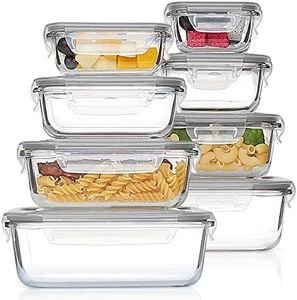
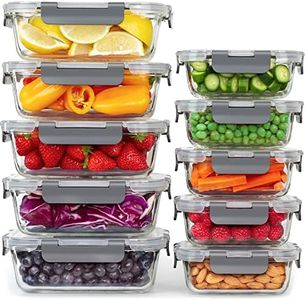

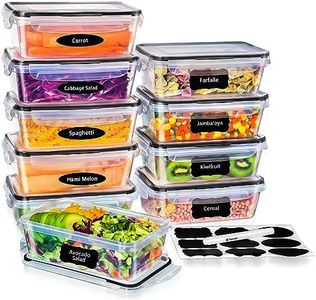
![Feshory 6 Pack [350 ML] Overnight Oats Container Jar with Screw Lid - Wide Mouth & Airtight Glass Food Storage Jar, Wide Mouth Glass Meal Prep Containers for Food, Salad, Spice, Snacks, Dressing Sauce](https://images-proxy.bestreviews.guide/MALbUTiuBayWpZK3RbzixrjHEVg=/0x300/https://m.media-amazon.com/images/I/31tLhB5cyeL._AC_CX679_.jpg)
